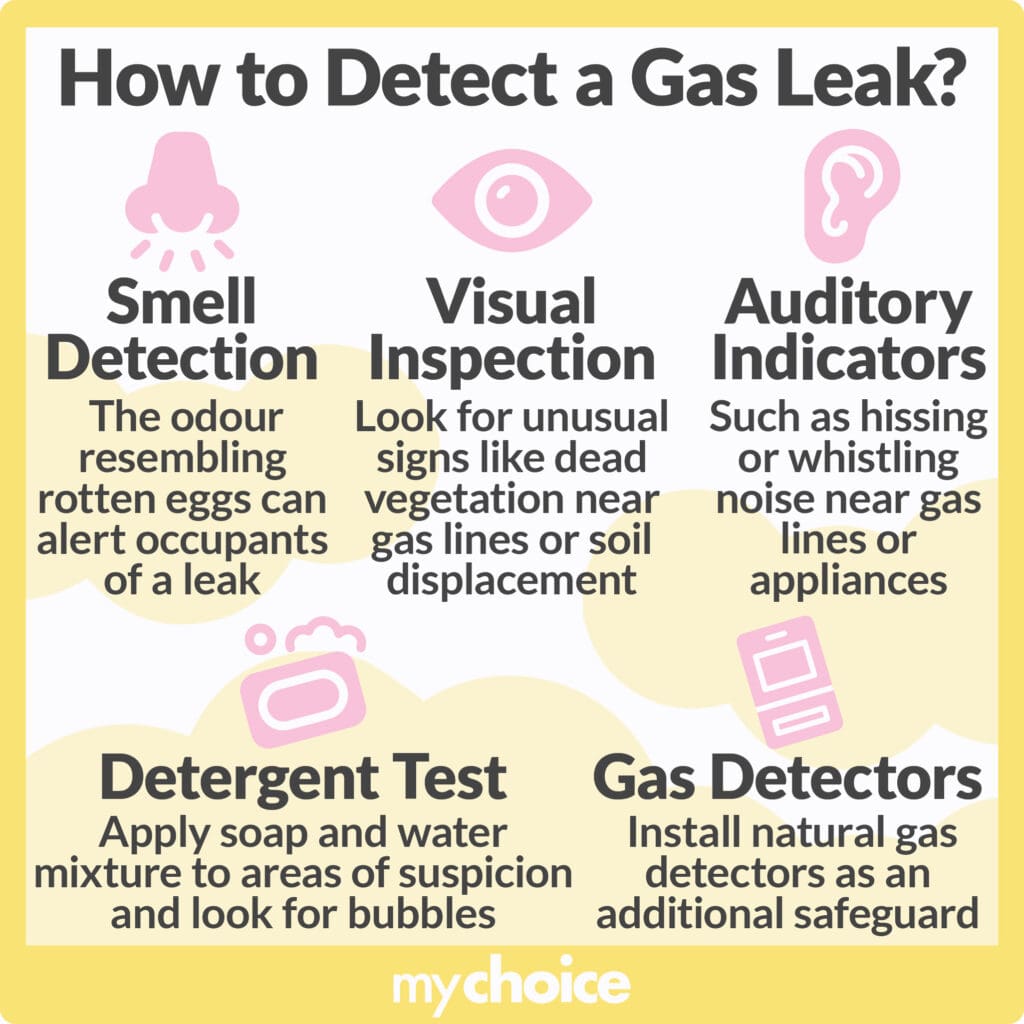Natural gas is a significant energy source in Canadian households, with natural gas accounting for 51.5% of total energy consumed in Canadian homes in 2021. It’s efficient and convenient for cooking and heating, but homeowners should always keep an eye out for the risk of gas leaks.
Gas leaks are tricky to detect because natural gas is odourless and colourless. Utility companies add a scent like rotten eggs to alert homeowners, but what other signs of a gas leak should you look out for? Keep reading to learn more about early gas leak detection and how to prevent leaks to keep your home and loved ones safe.
How to Detect a Gas Leak
Gas leaks are a serious health and safety hazard that can lead to explosions, fires, and carbon monoxide poisoning. In many cases, your nose will be the first thing that detects a gas leak. Here are other ways you can detect if your gas lines or appliances are leaking:
- Install a gas leak detector and check for alerts: Gas leak detectors are sensitive to levels of carbon monoxide and other toxic gases. Place a detector in every sleeping area – they’ll alert you in case there are unusually high amounts of certain gases in the air.
- Listen for hissing sounds: Stay quiet and focus for a second on the sounds around the room where you suspect there’s a gas leak. If you hear a whistling sound or hissing, it may be a large gas leak caused by one of your pipes or appliances.
- Sniff around for the distinct rotten egg smell: Natural gas is typically odourless, but providers now add a rotten egg smell so it’s easy for people to detect the presence of gas right away. If you smell this odour, you likely have a gas leak.
- Pay attention to your weekly gas use: Check your utility bill and compare it to past bills. If it’s mysteriously gone up but your usage has stayed the same, you may have a gas leak.
- Try the soapy water test: Try applying soapy water to areas you suspect are leaking, like your pipes or gas line connections. If you notice bubbles form, this may be a sign of gas escaping from a leak. Note that this sign is helpful, but not conclusive proof of a leak – so try the other things we listed above first.
- Look for dead or dying plants: Natural gas prevents plant roots from absorbing oxygen, killing plants slowly. Look for dead or dying house plants, wilting leaves and flowers, and yellowish grass patches around your gas lines or appliances.
- Check for physical symptoms of gas exposure: This should be considered a last-resort measure, as even brief gas exposure is dangerous to your health – and prolonged exposure is fatal. If you’re dizzy, suffering from a headache, nauseous, or breathing irregularly, call 911 and get immediate medical help as these may be signs of gas exposure from a leak.

How to Prevent Gas Leaks
Preventing gas leaks is a must for keeping your home a safe and healthy environment for your loved ones. It may take some time and effort, but you can prevent gas leaks and give yourself peace of mind by following these simple tips:
- Check and repair your appliances and fittings: Gas appliances and pipes will wear down over the years, so schedule maintenance appointments with a master plumber for a thorough check-up. This is also part of proper homeowner maintenance, as insurers may deny a claim for damages caused by negligence and failure to maintain your home.
- Upgrade outdated appliances: Older appliances cost more to maintain and are more likely to break down and leak gas. Upgrading your stove, gas heater, and other gas-fueled appliances will reduce the risk of gas leaks.
- Know your shut-off valve: Be familiar with your gas shutoff valve to quickly locate it and stop gas flow in an emergency situation.
- Call a professional to locate and repair a leak at once: Trying to fix a leak by yourself without the proper training, skills, and equipment can be dangerous. Call a licensed master plumber or your gas company to take care of the situation.
What To Do Immediately If You Suspect Or Confirm A Gas Leak
If you’ve spotted the signs of a gas leak, don’t waste time. Prioritize your safety and follow these steps immediately to protect your home and everyone inside it:
- Avoid using anything electrical or igniting any flames in your house: Don’t turn on any light switches and avoid using phones and other appliances. Likewise, don’t light any candles, strike matches, or do anything involving an open flame as electrical devices and open fire can ignite escaping gas with a spark.
- Evacuate your home ASAP: If you strongly suspect that there’s a leak, don’t spend time locating and repairing it yourself. Get your family members and pets out of your house immediately and make sure they’re away at a safe distance.
- Turn off your gas valve, then ventilate your home if possible: Locate and turn off your gas valve immediately. If it’s safe to take a few minutes, open doors and windows on your way out of your home to help the gas disperse.
- Call for help from a safe location: Once you’re at a safe distance from the leak, call a master plumber or gas company to report the leak and have it repaired immediately.
Are Gas Leaks Covered by Insurance?
Gas leaks are covered by insurance, but only if they cause damage to your home or property. For example, homeowners insurance typically covers damage caused by a fire that started because of a gas leak. However, the cost of repairing a leak usually isn’t covered by homeowners insurance.
These are other examples of situations where there are gas leaks that aren’t covered by homeowners insurance:
- Leaks from improperly installed or connected pipes
- Leaks caused by old appliances that aren’t regularly maintained
- Leaks caused by natural disasters that aren’t covered by your policy, e.g. floods or earthquakes
The cost of gas leak repair is only covered by your policy in certain circumstances, so be proactive about inspections and responding to signs of potential leaks.
Key Advice from MyChoice
- Schedule regular maintenance with a master plumber to ensure your gas pipes, fittings, and appliances are all in working order.
- Upgrade your gas-powered appliances. Not only are newer appliances less likely to break down, but they’re also usually more cost-efficient.
- A gas leak detector can detect elevated levels of carbon monoxide and other toxic gases that indicate a potential gas leak. As part of your regular home inspection and maintenance routine, check and replace your detectors’ batteries so they continue to protect your home.
- The soapy water test isn’t a reliable indicator of a gas leak, so don’t rely on it alone. Look for other signs like a sulphurous, rotten egg smell, dying house plants, or a hissing, whistling sound.
- Any gas leak is dangerous. Take the precaution of having everyone leave your home and alert the proper authorities. Turn off your meter or pilot light and avoid using electronics near your gas lines or appliances, as these may cause a spark that could ignite the gas.








